
The Four Stages of Cruelty
Encyclopedia
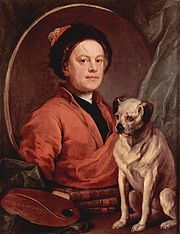
Engraving
Engraving is the practice of incising a design on to a hard, usually flat surface, by cutting grooves into it. The result may be a decorated object in itself, as when silver, gold, steel, or glass are engraved, or may provide an intaglio printing plate, of copper or another metal, for printing...
s published by English artist William Hogarth
William Hogarth
William Hogarth was an English painter, printmaker, pictorial satirist, social critic and editorial cartoonist who has been credited with pioneering western sequential art. His work ranged from realistic portraiture to comic strip-like series of pictures called "modern moral subjects"...
in 1751. Each print depicts a different stage in the life of the fictional Tom Nero.
Beginning with the torture of a dog
Cruelty to animals
Cruelty to animals, also called animal abuse or animal neglect, is the infliction of suffering or harm upon non-human animals, for purposes other than self-defense. More narrowly, it can be harm for specific gain, such as killing animals for food or for their fur, although opinions differ with...
as a child in the First stage of cruelty, Nero progresses to beating his horse as a man in the Second stage of cruelty, and then to robbery, seduction
Seduction
In social science, seduction is the process of deliberately enticing a person to engage. The word seduction stems from Latin and means literally "to lead astray". As a result, the term may have a positive or negative connotation...
, and murder in Cruelty in perfection. Finally, in The reward of cruelty, he receives what Hogarth warns is the inevitable fate of those who start down the path Nero has followed: his body is taken from the gallows
Gallows
A gallows is a frame, typically wooden, used for execution by hanging, or by means to torture before execution, as was used when being hanged, drawn and quartered...
after his execution as a murderer and is mutilated by surgeon
Surgery
Surgery is an ancient medical specialty that uses operative manual and instrumental techniques on a patient to investigate and/or treat a pathological condition such as disease or injury, or to help improve bodily function or appearance.An act of performing surgery may be called a surgical...
s in the anatomical theatre
Anatomical theatre
An anatomical theatre was an institution used in teaching anatomy at early modern universities.The theatre was usually a room of roughly amphitheatrical shape, in the centre of which would stand the table on which the dissections of human or animal bodies took place...
.
The prints were intended as a form of moral
Morality
Morality is the differentiation among intentions, decisions, and actions between those that are good and bad . A moral code is a system of morality and a moral is any one practice or teaching within a moral code...
instruction; Hogarth was dismayed by the routine acts of cruelty he witnessed on the streets of London. Issued on cheap paper, the prints were destined for the lower classes
Working class
Working class is a term used in the social sciences and in ordinary conversation to describe those employed in lower tier jobs , often extending to those in unemployment or otherwise possessing below-average incomes...
. The series shows a roughness of execution and a brutality that is untempered by the humorous touches common in Hogarth's other works, but which he felt was necessary to impress his message on the intended audience. Nevertheless, the pictures still carry the wealth of detail and subtle references that are characteristic of Hogarth.
History
In common with other prints by Hogarth, such as Beer Street and Gin LaneBeer Street and Gin Lane
Beer Street and Gin Lane are two prints issued in 1751 by English artist William Hogarth in support of what would become the Gin Act. Designed to be viewed alongside each other, they depict the evils of the consumption of gin as a contrast to the merits of drinking beer...
, The Four Stages of Cruelty was issued as a warning against immoral behaviour, showing the easy path from childish thug to convicted criminal. His aim was to correct "that barbarous treatment of animals, the very sight of which renders the streets of our metropolis so distressing to every feeling mind". Hogarth loved animals, picturing himself with his pug
Pug
The pug is a "toy" breed of dog with a wrinkly, short-muzzled face, and curled tail. The breed has a fine, glossy coat that comes in a variety of colors, and a compact square body with well-developed muscle. They have been described as multum in parvo , referring to the pug's personality and...
in a self-portrait, and marking the graves of his dogs and birds at his home in Chiswick
Chiswick
Chiswick is a large suburb of west London, England and part of the London Borough of Hounslow. It is located on a meander of the River Thames, west of Charing Cross and is one of 35 major centres identified in the London Plan. It was historically an ancient parish in the county of Middlesex, with...
.
Hogarth deliberately portrayed the subjects of the engravings with little subtlety since he meant the prints to be understood by "men of the lowest rank" when seen on the walls of workshops or tavern
Tavern
A tavern is a place of business where people gather to drink alcoholic beverages and be served food, and in some cases, where travelers receive lodging....
s. The images themselves, as with Beer Street and Gin Lane, were roughly drawn, lacking the finer lines of some of his other works. Fine engraving and delicate artwork would have rendered the prints too expensive for the intended audience, and Hogarth also believed a bold stroke could portray the passions of the subjects just as well as fine lines, noting that "neither great correctness of drawing or fine engraving were at all necessary".
To ensure that the prints were priced within reach of the intended audience, Hogarth originally commissioned the block-cutter J. Bell to produce the four designs as woodcut
Woodcut
Woodcut—occasionally known as xylography—is a relief printing artistic technique in printmaking in which an image is carved into the surface of a block of wood, with the printing parts remaining level with the surface while the non-printing parts are removed, typically with gouges...
s. This proved more expensive than expected, so only the last two of the four images were cut and were not issued commercially at the time. Instead, Hogarth proceeded to create the engravings himself and announced the publication of the prints, along with that of Beer Street and Gin Lane, in the London Evening Post
London Evening Post
The London Evening Post was a pro-Jacobite Tory English newspaper published in Great Britain from 1727 until 1797....
over three days from 14–16 February 1751. The prints themselves were published on 21 February 1751 and each was accompanied by a moralising commentary, written by the Rev. James Townley
James Townley
Rev. James Townley was an English dramatist and anonymous playwright, the second son of Charles Townley, a merchant.-Early and Personal life:...
, a friend of Hogarth's. As with earlier engravings, such as Industry and Idleness
Industry and Idleness
Industry and Idleness is the title of a series of 12 plot-linked engravings created by William Hogarth in 1747, intending to illustrate to working children the possible rewards of hard work and diligent application and the sure disasters attending a lack of both...
, individual prints were sold on "ordinary" paper for 1s. (one shilling
Shilling
The shilling is a unit of currency used in some current and former British Commonwealth countries. The word shilling comes from scilling, an accounting term that dates back to Anglo-Saxon times where it was deemed to be the value of a cow in Kent or a sheep elsewhere. The word is thought to derive...
, equating to about £ in terms), cheap enough to be purchased by the lower classes as a means of moral instruction. "Fine" versions were also available on "superior" paper for 1s. 6d. (one shilling and sixpence, about £ in terms) for collectors.
Variations on plates III and IV exist from Bell's original woodcuts, bearing the earlier date of 1 January 1750, and were reprinted in 1790 by John Boydell
John Boydell
John Boydell was an 18th-century British publisher noted for his reproductions of engravings. He helped alter the trade imbalance between Britain and France in engravings and initiated a British tradition in the art form...
, but examples from either of the woodcut printings are uncommon.
First stage of cruelty
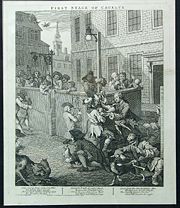
Nero
Nero , was Roman Emperor from 54 to 68, and the last in the Julio-Claudian dynasty. Nero was adopted by his great-uncle Claudius to become his heir and successor, and succeeded to the throne in 54 following Claudius' death....
or a contraction
Contraction (grammar)
A contraction is a shortened version of the written and spoken forms of a word, syllable, or word group, created by omission of internal letters....
of "No hero". Conspicuous in the centre of the plate, he is shown being assisted by other boys to insert an arrow into a dog's rectum
Rectum
The rectum is the final straight portion of the large intestine in some mammals, and the gut in others, terminating in the anus. The human rectum is about 12 cm long...
, a torture apparently inspired by a devil punishing a sinner in Jacques Callot
Jacques Callot
Jacques Callot was a baroque printmaker and draftsman from the Duchy of Lorraine . He is an important figure in the development of the old master print...
's Temptation of St. Anthony. An initialled badge on the shoulder of his light-hued and ragged coat shows him to be a pupil of the charity school
Charity school
A charity school, also called Blue Coat School, was significant in the History of education in England. They were erected and maintained in various parishes, by the voluntary contributions of the inhabitants, for teaching poor children to read, write, and other necessary parts of education...
of the parish of St Giles
St Giles, London
St Giles is a district of London, England. It is the location of the church of St Giles in the Fields, the Phoenix Garden and St Giles Circus. It is located at the southern tip of the London Borough of Camden and is part of the Midtown business improvement district.The combined parishes of St...
. Hogarth used this notorious slum
Slum
A slum, as defined by United Nations agency UN-HABITAT, is a run-down area of a city characterized by substandard housing and squalor and lacking in tenure security. According to the United Nations, the percentage of urban dwellers living in slums decreased from 47 percent to 37 percent in the...
area as the background for many of his works including Gin Lane and Noon, part of the Four Times of the Day
Four Times of the Day
Four Times of the Day is a series of four paintings by English artist William Hogarth. Completed in 1736, they were reproduced as a series of four engravings published in 1738. They are humorous depictions of life in the streets of London, the vagaries of fashion, and the interactions between the...
series. A more tender-hearted boy, perhaps the dog's owner, pleads with Nero to stop tormenting the frightened animal, even offering food in an attempt to appease him. This boy supposedly represents a young George III
George III of the United Kingdom
George III was King of Great Britain and King of Ireland from 25 October 1760 until the union of these two countries on 1 January 1801, after which he was King of the United Kingdom of Great Britain and Ireland until his death...
. His appearance is deliberately more pleasing than the scowling ugly ruffians that populate the rest of the picture, made clear in the text at the bottom of the scene:
While various Scenes of sportive Woe, The Infant Race employ, And tortur'd Victims bleeding shew, The Tyrant in the Boy. |
Behold! a Youth of gentler Heart, To spare the Creature's pain, O take, he cries—take all my Tart, But Tears and Tart are vain. |
Learn from this fair Example—You Whom savage Sports delight, How Cruelty disgusts the view, While Pity charms the sight. |

Link-boy
A link-boy was a boy who carried a flaming torch to light the way for pedestrians at night. Linkboys were common in London in the days before street lighting...
's torch; the boys in the foreground are throwing at a cock
Cock throwing
Cock throwing, also known as cock-shying or throwing at cocks, was a blood sport widely practised in England until the late 18th century. A rooster was tied to a post and people took turns throwing coksteles at the bird until it died...
(perhaps an allusion to a nationalistic enmity towards the French
Early Modern France
Kingdom of France is the early modern period of French history from the end of the 15th century to the end of the 18th century...
, and a suggestion that the action takes place on Shrove Tuesday
Shrove Tuesday
Shrove Tuesday is a term used in English-speaking countries, especially in Ireland, United Kingdom, Canada, Australia, New Zealand, Philippines, Germany, and parts of the United States for the day preceding Ash Wednesday, the first day of the season of fasting and prayer called Lent.The...
, the traditional day for cock-shying); another boy ties a bone to a dog's tail—tempting, but out of reach; a pair of fighting cats are hung by their tails and taunted by a jeering group of boys; in the bottom left-hand corner a dog is set on a cat; and in the rear of the picture another cat tied to two bladders is thrown from a high window. In a foreshadowing of his ultimate fate, Tom Nero's name is written under the chalk drawing of a man hanging from the gallows; the meaning is made clear by the schoolboy artist pointing towards Tom. The absence of parish officers who should be controlling the boys is an intentional rebuke on Hogarth's part; he agreed with Henry Fielding
Henry Fielding
Henry Fielding was an English novelist and dramatist known for his rich earthy humour and satirical prowess, and as the author of the novel Tom Jones....
that one of the causes for the rising crime rate was the lack of care from the overseers of the poor, who were too often interested in the posts only for the social status and monetary rewards they could bring.
Below the text the authorship is established: Designed by W. Hogarth, Published according to Act of Parliament. Feb. 1. 1751 The Act of Parliament
Act of Parliament
An Act of Parliament is a statute enacted as primary legislation by a national or sub-national parliament. In the Republic of Ireland the term Act of the Oireachtas is used, and in the United States the term Act of Congress is used.In Commonwealth countries, the term is used both in a narrow...
referred to is the Engraving Copyright Act 1734
Engraving Copyright Act 1734
The Engraving Copyright Act 1734 was an Act of the Parliament of Great Britain passed in 1734 to give protections to producers of engravings. It is sometimes called Hogarth's Act after William Hogarth, whose work prompted the law...
. Many of Hogarth's earlier works had been reproduced in great numbers without his authority or any payment of royalties
Royalties
Royalties are usage-based payments made by one party to another for the right to ongoing use of an asset, sometimes an intellectual property...
, and he was keen to protect his artistic property, so had encouraged his friends in Parliament
Parliament of the United Kingdom
The Parliament of the United Kingdom of Great Britain and Northern Ireland is the supreme legislative body in the United Kingdom, British Crown dependencies and British overseas territories, located in London...
to pass a law to protect the rights of engravers. Hogarth had been so instrumental in pushing the Bill through Parliament that on passing it became known as the "Hogarth Act".
Second stage of cruelty
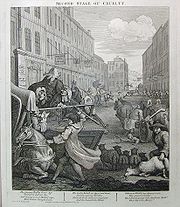
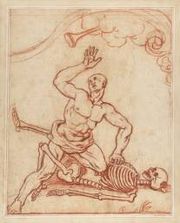
Thavies Inn
Thavies Inn was one of the Inns of Chancery and was situated on Holborn, near the site of the present side street and office block named Thavies Inn Buildings, at Holborn Circus. It was associated with Lincoln's Inn. Indeed it is this association that has become bound up with the origins of that...
Gate (sometimes ironically written as Thieves Inn Gate), one of the Inns of Chancery
Inns of Chancery
The Inns of Chancery or Hospida Cancellarie were a group of buildings and legal institutions in London initially attached to the Inns of Court and used as offices for the clerks of chancery, from which they drew their name...
which housed associations of lawyers in London. Tom Nero has grown up and become a hackney
Hackney carriage
A hackney or hackney carriage is a carriage or automobile for hire...
coachman
Coachman
A coachman is a man whose business it is to drive a coach, a horse-drawn vehicle designed for the conveyance of more than one passenger — and of mail — and covered for protection from the elements...
, and the recreational cruelty of the schoolboy has turned into the professional cruelty of a man at work. Tom's horse, worn out from years of mistreatment and overloading, has collapsed, breaking its leg and upsetting the carriage. Disregarding the animal's pain, Tom has beaten it so furiously that he has put its eye out. In a satirical aside, Hogarth shows four corpulent barrister
Barrister
A barrister is a member of one of the two classes of lawyer found in many common law jurisdictions with split legal professions. Barristers specialise in courtroom advocacy, drafting legal pleadings and giving expert legal opinions...
s struggling to climb out of the carriage in a ludicrous state. They are probably caricature
Caricature
A caricature is a portrait that exaggerates or distorts the essence of a person or thing to create an easily identifiable visual likeness. In literature, a caricature is a description of a person using exaggeration of some characteristics and oversimplification of others.Caricatures can be...
s of eminent jurists, but Hogarth did not reveal the subjects' names, and they have not been identified. Elsewhere in the scene, other acts of cruelty against animals take place: a drover
Drover (Britain)
A drovers' road, drove or droveway is a route for droving livestock on foot from one place to another, such as to market or between summer and winter pasture...
beats a lamb
Domestic sheep
Sheep are quadrupedal, ruminant mammals typically kept as livestock. Like all ruminants, sheep are members of the order Artiodactyla, the even-toed ungulates. Although the name "sheep" applies to many species in the genus Ovis, in everyday usage it almost always refers to Ovis aries...
to death, an ass
Donkey
The donkey or ass, Equus africanus asinus, is a domesticated member of the Equidae or horse family. The wild ancestor of the donkey is the African Wild Ass, E...
is driven on by force despite being overloaded, and an enraged bull
Bull-baiting
Bull-baiting is a blood sport involving the baiting of bulls.-History:In the time of Queen Anne of Great Britain, bull-baiting was practiced in London at Hockley-in-the-Hole, twice a week – and was reasonably common in the provincial towns...
tosses one of its tormentors. Some of these acts are recounted in the moral accompanying the print:
The generous Steed in hoary Age, Subdu'd by Labour lies; And mourns a cruel Master's rage, While Nature Strength denies. |
The tender Lamb o'er drove and faint, Amidst expiring Throws; Bleats forth it's innocent complaint And dies beneath the Blows. |
Inhuman Wretch! say whence proceeds This coward Cruelty? What Int'rest springs from barb'rous deeds? What Joy from Misery? |
The cruelty has also advanced to include abuse of people. A dray
Wagon
A wagon is a heavy four-wheeled vehicle pulled by draught animals; it was formerly often called a wain, and if low and sideless may be called a dray, trolley or float....
crushes a playing boy while the drayman
Drayman
A drayman was historically the driver of a dray, a low, flat-bed wagon without sides, pulled generally by horses or mules that were used for transport of all kinds of goods. Now the term is really only used for brewery delivery men, even though routine horse-drawn deliveries are almost entirely...
sleeps, oblivious to the boy's injury and the beer spilling from his barrels. Posters in the background advertise a cockfight
Cockfight
A cockfight is a blood sport between two roosters , held in a ring called a cockpit. Cockfighting is now illegal throughout all states in the United States, Brazil, Australia and in most of Europe. It is still legal in several U.S. territories....
and a boxing
Boxing
Boxing, also called pugilism, is a combat sport in which two people fight each other using their fists. Boxing is supervised by a referee over a series of between one to three minute intervals called rounds...
match as further evidence of the brutal entertainments favoured by the subjects of the image. The boxing match is to take place at Broughton's Amphitheatre, a notoriously tough venue established by the "father of pugilism", Jack Broughton
Jack Broughton
John "Jack" Broughton was an English bare-knuckle fighter. He was the first person to ever codify a set of rules to be used in such contests; prior to this the "rules" that existed were very loosely defined and tended to vary from contest to contest...
: a contemporary bill records that the contestants would fight with their left leg strapped to the floor, with the one with the fewest bleeding wounds being adjudged the victor. One of the advertised participants in the boxing match is James Field, who was hanged two weeks before the prints were issued and features again in the final image of the series; the other participant is George "the Barber" Taylor, who had been champion of England but was defeated by Broughton and retired in 1750. On Taylor's death in 1757, Hogarth produced a number of sketches of him wrestling Death, probably for his tomb.
In an echo of the first plate, there is but one person who shows concern for the welfare of the tormented horse. To the left of Nero, and almost unseen, a man notes down Nero's hackney coach number to report him.
Cruelty in perfection
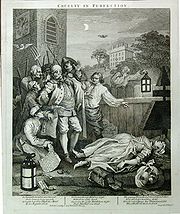
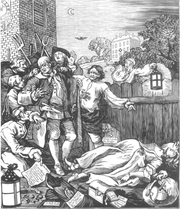
Index finger
The index finger, , is the first finger and the second digit of a human hand. It is located between the first and third digits, between the thumb and the middle finger...
are almost severed. Her trinket box and the goods she had stolen lie on the ground beside her, and the index finger of her partially severed hand points to the words "God's Revenge against Murder" written on a book that, along with the Book of Common Prayer
Book of Common Prayer
The Book of Common Prayer is the short title of a number of related prayer books used in the Anglican Communion, as well as by the Continuing Anglican, "Anglican realignment" and other Anglican churches. The original book, published in 1549 , in the reign of Edward VI, was a product of the English...
, has fallen from the box. A woman searching Nero's pockets uncovers pistols, a number of pocket watch
Pocket watch
A pocket watch is a watch that is made to be carried in a pocket, as opposed to a wristwatch, which is strapped to the wrist. They were the most common type of watch from their development in the 16th century until wristwatches became popular after World War I during which a transitional design,...
es—evidence of his having turned to highway robbery (as Tom Idle did in Industry and Idleness
Industry and Idleness
Industry and Idleness is the title of a series of 12 plot-linked engravings created by William Hogarth in 1747, intending to illustrate to working children the possible rewards of hard work and diligent application and the sure disasters attending a lack of both...
), and a letter from Ann Gill which reads:
The spelling is perfect and while this is perhaps unrealistic, Hogarth deliberately avoids any chance of the scene becoming comical. A discarded envelope is addressed "To Thos Nero at Pinne...". Ronald Paulson
Ronald Paulson
Ronald Paulson , is an American professor of English, a specialist in English 18th-century art and culture, and English artist William Hogarth.-Education:...
sees a parallel between the lamb beaten to death in the Second Stage and the defenceless girl murdered here. Below the print, the text claims that Nero, if not repentant, is at least stunned by his actions:
To lawless Love when once betray'd. Soon Crime to Crime succeeds: At length beguil'd to Theft, the Maid By her Beguiler bleeds. |
Yet learn, seducing Man! nor Night, With all its sable Cloud, can screen the guilty Deed from sight; Foul Murder cries aloud. |
The gaping Wounds and bloodstain'd steel, Now shock his trembling Soul: But Oh! what Pangs his Breast must feel, When Death his Knell shall toll. |
Various features in the print are meant to intensify the feelings of dread: the murder takes place in a graveyard, said to be St Pancras
St Pancras, London
St Pancras is an area of London. For many centuries the name has been used for various officially-designated areas, but now is used informally and rarely having been largely superseded by several other names for overlapping districts.-Ancient parish:...
but suggested by John Ireland to resemble Marylebone
Marylebone
Marylebone is an affluent inner-city area of central London, located within the City of Westminster. It is sometimes written as St. Marylebone or Mary-le-bone....
; an owl
Owl
Owls are a group of birds that belong to the order Strigiformes, constituting 200 bird of prey species. Most are solitary and nocturnal, with some exceptions . Owls hunt mostly small mammals, insects, and other birds, although a few species specialize in hunting fish...
and a bat
Bat
Bats are mammals of the order Chiroptera "hand" and pteron "wing") whose forelimbs form webbed wings, making them the only mammals naturally capable of true and sustained flight. By contrast, other mammals said to fly, such as flying squirrels, gliding possums, and colugos, glide rather than fly,...
fly around the scene; the moon shines down on the crime; the clock strikes one for the end of the witching hour
Witching hour
The witching hour is a the time of day when supernatural creatures such as witches, demons and ghosts are thought to appear and be at their most powerful, and black magic at its most effective...
. The composition of the image may allude to Anthony van Dyck
Anthony van Dyck
Sir Anthony van Dyck was a Flemish Baroque artist who became the leading court painter in England. He is most famous for his portraits of Charles I of England and his family and court, painted with a relaxed elegance that was to be the dominant influence on English portrait-painting for the next...
's The Arrest of Christ. A lone Good Samaritan
Parable of the Good Samaritan
The parable of the Good Samaritan is a parable told by Jesus and is mentioned in only one of the Canonical gospels. According to the Gospel of Luke a traveller is beaten, robbed, and left half dead along the road. First a priest and then a Levite come by, but both avoid the man. Finally, a...
appears again: among the snarling faces of Tom's accusers, a single face looks to the heavens in pity.
In the alternative image for this stage, produced as a woodcut by Bell, Tom is shown with his hands free. There are also differences in the wording of the letter and some items, like the lantern and books, are larger and simpler while others, such as the man to the left of Tom and the topiary
Topiary
Topiary is the horticultural practice of training live perennial plants, by clipping the foliage and twigs of trees, shrubs and subshrubs to develop and maintain clearly defined shapes, perhaps geometric or fanciful; and the term also refers to plants which have been shaped in this way. It can be...
bush, have been removed. The owl has become a winged hourglass
Hourglass
An hourglass measures the passage of a few minutes or an hour of time. It has two connected vertical glass bulbs allowing a regulated trickle of material from the top to the bottom. Once the top bulb is empty, it can be inverted to begin timing again. The name hourglass comes from historically...
on the clock tower.
The reward of cruelty
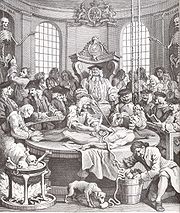
Hanging
Hanging is the lethal suspension of a person by a ligature. The Oxford English Dictionary states that hanging in this sense is "specifically to put to death by suspension by the neck", though it formerly also referred to crucifixion and death by impalement in which the body would remain...
and his body taken for the ignominious process of public dissection. The year after the prints were issued, the Murder Act 1752 would ensure that the bodies of murderers could be delivered to the surgeons so they could be "dissected and anatomised". It was hoped this further punishment on the body and denial of burial would act as a deterrent. At the time Hogarth made the engravings, this right was not enshrined in law, but the surgeons still removed bodies when they could.
A tattoo
Tattoo
A tattoo is made by inserting indelible ink into the dermis layer of the skin to change the pigment. Tattoos on humans are a type of body modification, and tattoos on other animals are most commonly used for identification purposes...
on his arm identifies Tom Nero, and the rope still around his neck shows his method of execution. The dissectors, their hearts hardened after years of working with cadavers, are shown to have as much feeling for the body as Nero had for his victims; his eye is put out just as his horse's was, and a dog feeds on his heart, taking a poetic revenge for the torture inflicted on one of its kind in the first plate. Nero's face appears contorted in agony and although this depiction is not realistic, Hogarth meant it to heighten the fear for the audience. Just as his murdered mistress's finger pointed to Nero's destiny in Cruelty in Perfection, in this print Nero's finger points to the boiled bones being prepared for display, indicating his ultimate fate.
While the surgeons working on the body are observed by the mortar-boarded
Square academic cap
The square academic cap, graduate cap, or mortarboard or Oxford cap, is an item of academic head dress consisting of a horizontal square board fixed upon a skull-cap, with a tassel attached to the center...
academics in the front row, the physicians, who can be identified by their wigs and canes, largely ignore the dissection and consult among themselves. The president has been identified as John Freke
John Freke
John Freke was an English surgeon. Together with Percival Pott he was instrumental in separating the profession of surgeon from that of barber.Freke was the son of a rural minister from Ockford Fitzpaine, Dorset...
, president of the Royal College of Surgeons
Royal College of Surgeons of England
The Royal College of Surgeons of England is an independent professional body and registered charity committed to promoting and advancing the highest standards of surgical care for patients, regulating surgery, including dentistry, in England and Wales...
at the time. Freke had been involved in the high-profile attempt to secure the body of condemned rioter Bosavern Penlez
Bosavern Penlez
Bosavern Penlez was a British wig maker who was convicted and executed for rioting along with co-defendant John Wilson. He was sentenced and hanged on October 18, 1749....
for dissection in 1749.
Aside from the over-enthusiastic dissection of the body and the boiling of the bones in situ
In situ
In situ is a Latin phrase which translated literally as 'In position'. It is used in many different contexts.-Aerospace:In the aerospace industry, equipment on board aircraft must be tested in situ, or in place, to confirm everything functions properly as a system. Individually, each piece may...
, the image portrays the procedure as it would have been carried out.
Two skeletons to the rear left and right of the print are labelled as James Field, a well-known boxer who also featured on a poster in the second plate, and Macleane
James MacLaine
"Captain" James MacLaine was a notorious highwayman with his accomplice William Plunkett. He was known as the "Gentleman Highwayman" as a result of his courteous behaviour during his robberies. He famously robbed Horace Walpole, and was eventually hanged at Tyburn...
, an infamous highwayman
Highwayman
A highwayman was a thief and brigand who preyed on travellers. This type of outlaw, usually, travelled and robbed by horse, as compared to a footpad who traveled and robbed on foot. Mounted robbers were widely considered to be socially superior to footpads...
. Both men were hanged shortly before the print was published (Macleane in 1750 and Field in 1751). The skeletons seemingly point to one another. Field's name above the skeleton on the left may have been a last minute substitution for "GENTL HARRY" referring to Henry Simms
Henry Simms
Henry Simms , known as Young Gentlemen Harry, was a thief and highwayman in 18th-century England who was transported to Maryland for theft, but escaped and returned to England, where he was eventually executed for highway robbery....
, also known as Young Gentleman Harry. Simms was a robber who was executed in 1747. The motif of the lone "good man" is carried through to this final plate, where one of the academics points at the skeleton of James Field, indicating the inevitable outcome for those who start down the path of cruelty.
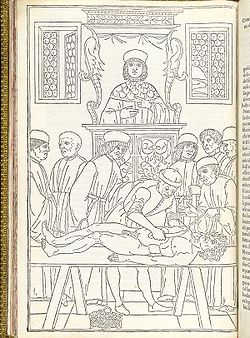
Pastiche
A pastiche is a literary or other artistic genre or technique that is a "hodge-podge" or imitation. The word is also a linguistic term used to describe an early stage in the development of a pidgin language.-Hodge-podge:...
of the frontispiece of Andreas Vesalius
Vesalius
Andreas Vesalius was a Flemish anatomist, physician, and author of one of the most influential books on human anatomy, De humani corporis fabrica . Vesalius is often referred to as the founder of modern human anatomy. Vesalius is the Latinized form of Andries van Wesel...
's De humani corporis fabrica
De humani corporis fabrica
De humani corporis fabrica libri septem is a textbook of human anatomy written by Andreas Vesalius in 1543....
, and it possibly also borrows from Quack Physicians' Hall (c. 1730) by the Dutch artist Egbert van Heemskerck, who had lived in England and whose work Hogarth admired. An earlier source of inspiration may have been a woodcut in the 1495 Fasciculo di medicina
Fasciculus medicinae
Fasciculus Medicinae is a “bundle” of six independent and quite different medieval medical treatises. The collection, which existed only in two manuscripts , was first printed in 1491 in Latin and came out in numerous editions over the next 25 years...
by Johannes de Ketham which, although simpler, has many of the same elements, including the seated president flanked by two windows.
Below the print are these final words:
Behold the Villain's dire disgrace! Not Death itself can end. He finds no peaceful Burial-Place, His breathless Corse, no friend. |
Torn from the Root, that wicked Tongue, Which daily swore and curst! Those Eyeballs from their Sockets wrung, That glow'd with lawless Lust! |
His Heart expos'd to prying Eyes, To Pity has no claim; But, dreadful! from his Bones shall rise, His Monument of Shame. |
Reception
Hogarth was pleased with the results. European Magazine reported that he commented to a bookseller from Cornhill (a Mr. Sewell):In his unfinished Apology for Painters he commented further:
In his 1817 book Shakespeare and His Times, Nathan Drake credits the representation of "throwing at cocks" in the first plate for changing public opinion about the practice, which was common at the time, and prompting magistrates to take a harder line on offenders.
Others found the series less to their liking. Charles Lamb dismissed the series as mere caricature, not worthy to be included alongside Hogarth's other work, but rather something produced as the result of a "wayward humour" outside of his normal habits. Art historian Allan Cunningham also had strong feelings about the series:
The Anatomy Act 1832
Anatomy Act 1832
The Anatomy Act 1832 was a United Kingdom Act of Parliament that gave freer license to doctors, teachers of anatomy, and bona fide medical students to dissect donated bodies...
ended the dissection of murderers, and most of the animal tortures depicted were outlawed by the Cruelty to Animals Act 1835
Cruelty to Animals Act 1835
The Cruelty to Animals Act 1835 was an Act of the Parliament of the United Kingdom , which was intended to protect animals from mistreatment....
, so by the 1850s The Four Stages of Cruelty had come to be viewed as a somewhat historical series, though still one with the power to shock, a power it retains for a modern audience.
In Popular Culture
The engravings were adapted for the stage in 2011 by ensemble theatre company Simple 8Simple 8
Simple 8 is a London-based theatre company formed in 2004 by professional actors, writers and directors. They aim to produce innovative, original, ensemble theatre.In 2006 they staged an adaptation of Les Enfants du Paradis...
.

